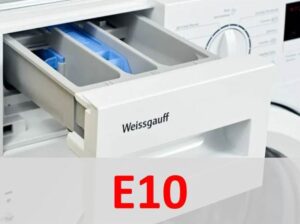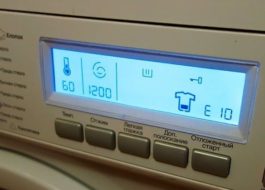Error E10 in Weissgauff washing machine
 Often, it is simply impossible to guess on your own why the washing machine stopped working. Fortunately, modern equipment always promptly informs the user of the cause of the malfunction. Thus, error E10 in the Weissgauff washing machine signals that the “home assistant”, for some reason, is not able to draw water to wash or rinse things. This is usually due to a lack of water in the water supply, but can also happen due to damage to parts of the SM. Let's look at the main causes of the problem and how to deal with them at home.
Often, it is simply impossible to guess on your own why the washing machine stopped working. Fortunately, modern equipment always promptly informs the user of the cause of the malfunction. Thus, error E10 in the Weissgauff washing machine signals that the “home assistant”, for some reason, is not able to draw water to wash or rinse things. This is usually due to a lack of water in the water supply, but can also happen due to damage to parts of the SM. Let's look at the main causes of the problem and how to deal with them at home.
List of potential breakdowns
The E10 fault code can appear due to a number of reasons, which may take several hours of free time to sort out. When there is water in the water supply and the hatch door is slammed shut, it means that you will have to carry out a thorough diagnosis. The error could have occurred for a number of reasons.
- Damaged intake valve. This needs to be checked first, because this is often what happens with technology. Remember how household chemicals were washed out of the powder receptacle until it broke down. If the detergent remains almost untouched during the operating cycle, then the element has failed. Just in case, you should check it with a small test - connect to the network and apply 220 Volts to the inlet valve. If the element is in good condition, it will close with a characteristic click, but if it is damaged, it simply will not respond to voltage.

- Filter mesh clogged.Due to the fact that tap water is generally very hard and dirty, many impurities and other debris remain on the filter element installed directly at the entrance to the washing machine. If the grid is clogged, then the household appliances will make a loud noise while unsuccessfully drawing water.

- The coarse filter is clogged. Sometimes the reason is hidden in the second filter that is installed in the water supply system. It also very often becomes dirty due to poor-quality tap water, so the drum is not filled with liquid for the working cycle.
- Broken pressure switch. Another extremely common cause of this DTC. If the water level sensor fails, the machine cannot track the current water level and stops working so that the cycle does not continue with insufficient or excess water. To check the pressure switch, you need to remove the cover of the household appliance, find the element, unhook the tube from it and try to blow into it - if you hear several soft clicks, then the device is working. If you receive silence in response, you will have to either clean the part or buy a new pressure switch, if even cleaning does not help it.

- Damage to the water level sensor hose. Over time, the pipe may lose its tightness, so it should also be checked and replaced from time to time.
- A crushed filling hose. Sometimes heavy objects, such as the SM body, are accidentally placed on the hose, which blocks the water supply.

- Failed pump. Before starting work, the system automatically drains all the waste liquid that remained in the machine after the last working cycle.But if the pump is broken, then the water will not be pumped out, so the control module will not start a new supply of water.

- Faulty control module. The most unpleasant cause of the error is the failure of the “brain” of the household appliance, which starts and controls the operation of all components of the “home assistant”. If the module is damaged, the entire system will not respond to commands, making washing impossible.
All the reasons are listed, it’s time to deal with them with your own hands.
How to find the problem yourself?
If you want to do repairs at home, then first of all you need to carry out a complete diagnosis. Disconnect the washing machine from the water supply and electrical network, and then proceed to check, starting with the simplest one.
- Make sure that there is water at home, which is enough to open the tap in any room.
- Check the valve on the water supply to make sure that liquid is flowing into the machine.

- Drain the inlet hose and inspect it carefully to make sure it is not pinched, clogged, or damaged.
If all is well, then you will have to start studying the filter mesh, a small round attachment placed in the filling sleeve. If it is severely clogged, then water will not enter the system until the filter element is cleaned. What should I do to correct the situation?
- Remove the filler hose from the washing machine.

- Find the filter mesh in the hose.

- Secure the protruding part of the mesh with pliers and remove it.

- Rinse the part under a powerful stream of hot water, and if necessary, carefully go over it with an old toothbrush to remove all dirt.
- Place the filter back into its seat.
Be especially careful when disconnecting the inlet hose - it always contains waste liquid, which can flood the floors if you do not replace the water container in a timely manner.
Sometimes the “home assistant” does not draw water because the coarse filter is clogged. This filter element is installed just behind the faucet, so you will first need to remove a few other elements using a wrench. Remember that when the clamp is removed, a stream of water will flow out of the pipe, which will wash away all contaminants from the coarse filter. Just prepare a basin for water in advance, and the whole procedure will go without any problems.
Intake valve diagnostics
Most often, the E10 trouble code appears due to a damaged intake valve. Repair in this case is not necessary, because it is difficult to cope with it yourself - it is much easier to dismantle the old part and install a new one. You can do this yourself if you strictly follow the instructions.
- Unplug the washing machine.

- Turn off the water supply tap.

- Drain the water from the filler hose and disconnect it.

- Remove the SM cover, having first removed the clamps.

- Find the intake valve and disconnect all wiring and pipes from it.
Take a few photos of the correct connection of the elements to the valve so that you have an example at hand later.
- Loosen the fixing bolt.
- Remove the valve from the machine.

- Install a new element in its place.
- Secure it with the retaining bolt.
- Connect the pipes and wiring to it.
- Replace the washer cover.
- Reconnect the filling hose.
Now the washing machine Weissgauff can be connected to all communications and a test work cycle can be carried out without clothes.The repair is successful if water flows freely into the powder receptacle and into the tank again. Additionally, you should check the inlet hose - the joint must be dry, without drops or leaks.
Contact the repair service if the situation with fault code E10 occurs again after all the manipulations have been performed.
The lack of water in the machine is a serious problem, because household appliances will not be able to carry out a single operating cycle in this condition. Carefully follow our instructions to correct the situation yourself at home.
Interesting:
Reader comments
- Share your opinion - leave a comment





















Add a comment